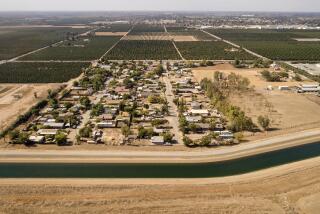Upside of State’s Water Crisis: No More Washing My Car
- Share via
It was one more reason to raise a glass on New Year’s Eve.
At midnight, the federal government kinked the hose that runs from the Colorado River to millions of Southern California homes, and it was just the excuse I needed to never again wash the car.
“It was a blessing in disguise,” says organic farmer Michael Ableman, founder of the Center for Urban Agriculture. “We’re not living within our means, and we’re not living within the ecology of our region....I’ll be honest with you. I think a lawn in California should be illegal. This isn’t Scotland.”
No washing the car. No watering and mowing the lawn.
This is sounding better all the time. But I suppose some history is in order.
As a native Californian, I know from experience that people have trouble staying awake when you start telling water stories. They nod politely at first, having heard that this stuff is supposed to be important somehow. But at the first mention of acre-feet, their eyes roll back in their heads and they’re gone.
I’m here to tell you the state’s entire history can be summarized in two sentences.
Too many people. Not enough water.
Sensible pioneers would have said OK, let’s move to Oregon or Michigan, or better yet, they might have said maybe we shouldn’t put 20 million people and 6 billion acres of asphalt in the middle of a desert.
Sensible people would have said, Hey, maybe we shouldn’t plant thirsty crops like cotton, rice and alfalfa in a place filled with tumbleweeds.
But this is California. Not much water, even less common sense.
In the never-ending water war, which has shaped the very landscape of the state, there are no heroes. Only knaves, curs and thieves, and they have been governed by one creed:
Let not mountain, nor desert, nor bout of conscience stand in the way of stealing someone else’s water.
San Francisco raided Hetch Hetchy. Los Angeles drained Owens Valley. Southern California tapped the Colorado. Farmers, who control 80% of the state’s water and don’t conserve like the rest of us, will siphon it from anywhere they can get it, and fight you off with rakes and hoes if you knock at the door dying of thirst.
Which brings us back to New Year’s Eve.
The Department of Interior would have kept our Colorado Aqueduct spigot wide open if four feuding water districts had agreed on a redistribution plan by midnight. The idea was to transfer water from Imperial Valley farmers, who don’t need their full allotment, to parched coastal cities.
San Diego was willing to buy 200,000 acre-feet of water from the Imperial Irrigation District for $258 an acre-foot, even though the district pays only $15.50, thanks to taxpayer subsidies.
But the farmers held out, then insisted on eleventh-hour changes, and the whole deal fell apart. As a penalty, guess what the feds are doing? Taking away the 200,000 acre-feet the agency could have sold to San Diego at a huge profit.
These Aggies must have descended from the kid who sold the cow for three magic beans.
There’s a good chance these boys are going to wake up and call the feds, begging to put the deal back together. But I’m praying it doesn’t happen, because like Ableman said, this whole thing is a blessing in disguise.
Let the farmers hoard all the water they want out there in hell’s sandbox. I like the idea of the rest of us being forced to live within our means. Is there anyone who thinks Southern California needs more front lawns, or more of the sprawl that water made possible?
Local officials say there’s no shortage to worry about just yet, because even with the feds draining the pool, we’ve banked enough water to keep ice cubes in our scotch for a while.
But I’m ready to start conserving today. Here in the capital of the world’s car culture, I’m willing to make the filthy sedan a new symbol of social responsibility. And guess who might be helping me with drought-resistant gardening tips?
Rene Russo.
The actress is starring in a Metropolitan Water District campaign to reduce outdoor watering. When I called MWD Vice President Adan Ortega Jr., he told me that both Russo and water district CEO Ronald R. Gastelum are in the middle of re-landscaping their yards, ripping out water-guzzling plants and replacing them with native plants.
I’m sure Gastelum’s little project is coming along nicely, but I’m holding out for a tour of Rene Russo’s house in Brentwood. If you see a dust-covered Nissan Sentra headed west, raise a green thumb.
*
Steve Lopez writes Sunday, Wednesday and Friday. Reach him at steve.lopez@latimes.
com.
More to Read
Sign up for Essential California
The most important California stories and recommendations in your inbox every morning.
You may occasionally receive promotional content from the Los Angeles Times.











